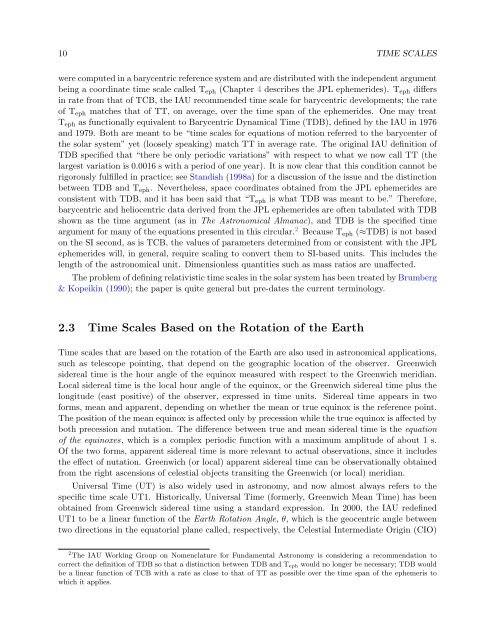USNO Circular 179 - U.S. Naval Observatory
USNO Circular 179 - U.S. Naval Observatory
USNO Circular 179 - U.S. Naval Observatory
You also want an ePaper? Increase the reach of your titles
YUMPU automatically turns print PDFs into web optimized ePapers that Google loves.
10 TIME SCALES<br />
were computed in a barycentric reference system and are distributed with the independent argument<br />
being a coordinate time scale called Teph (Chapter 4 describes the JPL ephemerides). Teph differs<br />
in rate from that of TCB, the IAU recommended time scale for barycentric developments; the rate<br />
of Teph matches that of TT, on average, over the time span of the ephemerides. One may treat<br />
Teph as functionally equivalent to Barycentric Dynamical Time (TDB), defined by the IAU in 1976<br />
and 1979. Both are meant to be “time scales for equations of motion referred to the barycenter of<br />
the solar system” yet (loosely speaking) match TT in average rate. The original IAU definition of<br />
TDB specified that “there be only periodic variations” with respect to what we now call TT (the<br />
largest variation is 0.0016 s with a period of one year). It is now clear that this condition cannot be<br />
rigorously fulfilled in practice; see Standish (1998a) for a discussion of the issue and the distinction<br />
between TDB and Teph. Nevertheless, space coordinates obtained from the JPL ephemerides are<br />
consistent with TDB, and it has been said that “Teph is what TDB was meant to be.” Therefore,<br />
barycentric and heliocentric data derived from the JPL ephemerides are often tabulated with TDB<br />
shown as the time argument (as in The Astronomical Almanac), and TDB is the specified time<br />
argument for many of the equations presented in this circular. 2 Because Teph (≈TDB) is not based<br />
on the SI second, as is TCB, the values of parameters determined from or consistent with the JPL<br />
ephemerides will, in general, require scaling to convert them to SI-based units. This includes the<br />
length of the astronomical unit. Dimensionless quantities such as mass ratios are unaffected.<br />
The problem of defining relativistic time scales in the solar system has been treated by Brumberg<br />
& Kopeikin (1990); the paper is quite general but pre-dates the current terminology.<br />
2.3 Time Scales Based on the Rotation of the Earth<br />
Time scales that are based on the rotation of the Earth are also used in astronomical applications,<br />
such as telescope pointing, that depend on the geographic location of the observer. Greenwich<br />
sidereal time is the hour angle of the equinox measured with respect to the Greenwich meridian.<br />
Local sidereal time is the local hour angle of the equinox, or the Greenwich sidereal time plus the<br />
longitude (east positive) of the observer, expressed in time units. Sidereal time appears in two<br />
forms, mean and apparent, depending on whether the mean or true equinox is the reference point.<br />
The position of the mean equinox is affected only by precession while the true equinox is affected by<br />
both precession and nutation. The difference between true and mean sidereal time is the equation<br />
of the equinoxes, which is a complex periodic function with a maximum amplitude of about 1 s.<br />
Of the two forms, apparent sidereal time is more relevant to actual observations, since it includes<br />
the effect of nutation. Greenwich (or local) apparent sidereal time can be observationally obtained<br />
from the right ascensions of celestial objects transiting the Greenwich (or local) meridian.<br />
Universal Time (UT) is also widely used in astronomy, and now almost always refers to the<br />
specific time scale UT1. Historically, Universal Time (formerly, Greenwich Mean Time) has been<br />
obtained from Greenwich sidereal time using a standard expression. In 2000, the IAU redefined<br />
UT1 to be a linear function of the Earth Rotation Angle, θ, which is the geocentric angle between<br />
two directions in the equatorial plane called, respectively, the Celestial Intermediate Origin (CIO)<br />
2 The IAU Working Group on Nomenclature for Fundamental Astronomy is considering a recommendation to<br />
correct the definition of TDB so that a distinction between TDB and Teph would no longer be necessary; TDB would<br />
be a linear function of TCB with a rate as close to that of TT as possible over the time span of the ephemeris to<br />
which it applies.


